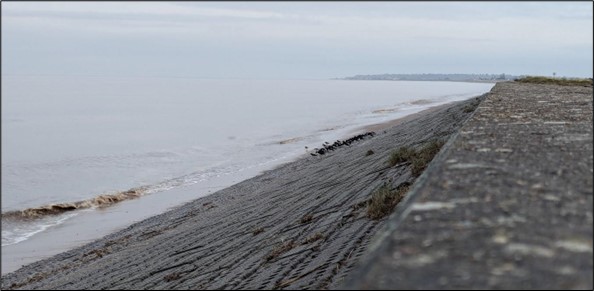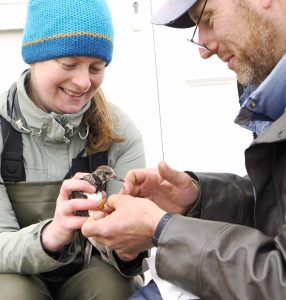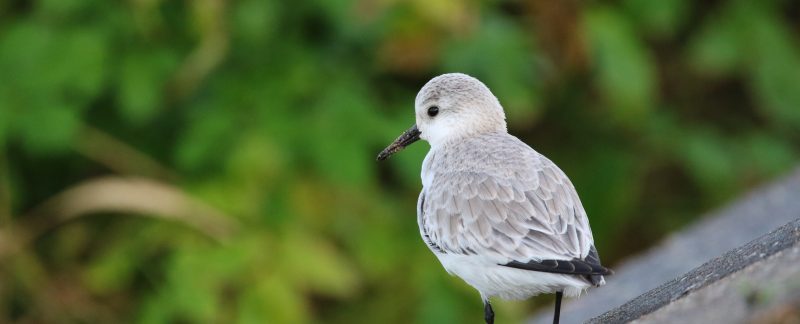Friday 9 February
Cathy braved some pretty awful weather to recce on Friday morning. There was a nice flock of around 400 Oystercatcher roosting on the dam itself, whilst Heacham South was unusually quiet for people, dogs and birds. There were small numbers of birds at Heacham North, with around 50 Oystercatcher, Grey Plover, Turnstone, Ringed Plover, Sanderling and Knot, all well distributed along the beach and not suitable for catching unfortunately.
Tim arrived to help with the afternoon recce, and along with his arrival came some nicer weather. Both Cathy and Tim were on site well before tide, finding the beach at Snettisham virtually empty; most Bar-tailed Godwit were still offshore and headed straight to the pits as the tide came in, with Oystercatcher doing a similar thing. At the dam, there were around 300 Oystercatcher loafing on the Mussel scar just offshore. As the tide came in, there were well over 1,000 Oystercatcher gathered on the mud around the dam and further north at Heacham, most of which eventually gathered on the Mussel scar. Eventually, around 200 birds came ashore south of the Tump, whilst the rest of the birds gathered on the scar were scared off by dogs and headed south to Snettisham.
It was decided that there wasn’t a suitable catch option considering the location of the birds, the height of the tide and when it would get light so Saturday morning would be dedicated to further recces and resighting effort along the coast with a view to attempt catches on Saturday afternoon and Sunday morning. Most folk then gathered at the base for dinner and briefing. There was an important acknowledgement that this weekend was to be a particularly hard one, as the first WWRG trip following the tragic passing of our dear friend, colleague and wader champion, Mark Smart.
Saturday 10 February
Saturday began particularly early (04:45) for Lucy and Ed T, as they headed off to monitor the Oystercatcher coming in to roost on the dam with a view to a possible catch on Sunday morning. With the use of a thermal camera, it was possible to see around 100 birds roosting on the dam before first light, which included 70 Oystercatcher, 12 Knot and 10 Dunlin.
Everyone else was up between 06:30 and 07:30 ready to head out….
- Cathy, Tim and Shannon headed out to the fields to check for Curlew. There was a decent sized flock of 30 Curlew in one of the first few fields to be checked, but unfortunately bar a few birds separate from the main flock, all were too far away to check for flags. No other Curlew were seen in the remaining fields.
- Claudia and Liam headed to check fields around Heacham and Heacham North North beach. In the fields were around 150 Curlew, with 11 flags read. At Heacham NN there were small flocks of Turnstone (9), Sanderling (20) and Ringed Plover (30).
- Ian and Seb covered Snettisham Beach. There were plenty of dog walkers so not many birds, but they still managed to read two flagged Bar-tailed Godwit and one flagged Curlew.
- Eddie and Bee covered Heacham South where it was relatively quiet, with one Curlew flag read, which was the only bird present amongst a larger flock of Oystercatcher.
- Guy, arriving on Saturday morning, went straight to Hunstanton to look for Turnstone. He had 36, five of which were colour-marked and read, alongside six Curlew (one flag read) and 75 Oystercatcher (one colour ring read).
- Nigel and Katharine visited the Terrington fields near the base, first surveyed on Boxing Day 2022, and found 62 Curlew feeding on the fields towards Admiral’s Farm, but no flags on any of their legs. Heading west towards Bellmount, 16 Curlew with a flagged bird were seen in a field but they flew off before it could be read. Finally, on the way back 29 Curlew were seen feeding at the corner of Tower Farm but again no flags were seen. Small numbers of Curlew – 1–4 were seen in small groups between these major flocks but in the general three areas mentioned.
- Hilary, James, Skye, Jacquie and Rob (and Katharine and Nigel, after their trip around the local fields) stayed at the base house to sort ring stocks and colour rings, work on data and make breakfast for everyone.

The team were back at base for 11:00, but with some a little late back (getting that last resighting!) breakfast was delayed, and the pressure was on to get everything packed ready for departing to set cannon nets at 13:15. With everyone chipping in, we departed on time, and made it to Heacham South. The nets were set quickly and efficiently though it took a while to resolve problems with circuit testing, eventually traced to a chocolate block that had become partially disconnected from the dropper cable. A spare dropper was brought out, decoys went set and everyone cleared the beach. It wasn’t long before Oystercatchers started coming in, and soon a flock of around 100 birds had built up.
Given the speed at which the birds were coming in, the beach team needed to get in position quickly. It was then that it suddenly dawned on us that there wasn’t a firing box; unfortunately, in the haste to get away from the base, the team had forgotten it. We tried an alternative way of firing but were unsuccessful – not helped by cable issues and the rapidly rising tide. The team was quickly onto the beach to lift the net and move decoys away from the approaching tide – but not before the decoys had had a short swim.
The team gathered back at base for chip butties and a de-brief. Despite some disappointment, there was hope for an early catch tomorrow at Heacham North North.
Sunday 11 February
Another 04:45 start to make the early tide. The trailer was already packed, so the team were out and on the beach, in the drizzle, by 06:15. An experienced crew were sent to set a single net, but with the tide so high, and very little of Heacham North North beach left, it was decided to attempt a catch on the falling tide as birds and tide edge were too close to the net (which was right at the back of the beach) to be able to fire safely at high tide. The team huddled on the sea wall, receiving the odd look from early-morning joggers and dog walkers, waiting for the tide to start falling.
It wasn’t long before the tide had turned, grey decoys were out and the firing team were in position. There was a ‘tame’ flock of around 200 Sanderling, which were gathered around 20 m from Lucy in her firing position. However, when we attempted to twinkle them into the catching area as the tide fell to a safe distance from the net, rather frustratingly, they left the beach completely. There were still some birds left on the beach though, and with around 30 birds in the catching area the net was fired.
The team sprinted onto the beach and executed a textbook lift and moved birds and net away from the sea. With everything safely extracted, given the tide was still relatively high, it was decided that we would reset the net in the hope the large flock of Sanderling would return. With maximum efficiency, the net was reset and everyone was off the beach. With only a small catching window before the tide fell too far, twinklers were sent up the beach again. After a few minutes, there was a small flock of around 15 Oystercatcher in the catching area, and with time running out the decision was made to fire. Sadly, most of the Oystercatcher beat the net, which was still rather wet from the first catch. Still, three birds were caught, so it wasn’t entirely in vain. Birds were extracted, the net was laid out to dry and the equipment was lifted off the beach in minimal time, and the team were soon ready to start processing birds.

Given the catch was on the smaller side, it provided a great opportunity for some training. Michelle did some excellent tutoring with Ed on the finer points of WWRG scribing, Guy did some training with Seb and Liam practising bill measurements and Eddie helped Katharine with fitting the colour-rings to the Turnstone. In total, 11 Oystercatcher, seven Turnstone, seven Sanderling and one Ringed Plover were caught. Remarkably, six of the seven Sanderling were retraps! All the Turnstone were colour-ringed, adding another valuable sample to the population.
The team gathered for a de-brief, and to the very exciting news that the WWRG has a new member; a baby girl born to Sam and David and sister Skye (Eden). Congratulations to you all! The team then took some time to sit on the beach and remember Mark, and to round things off, we all played a new game Skye invented which involved hopping on one leg, picking up stones and juggling them. It turns out that there are some rather talented jugglers in the team….
The team returned to the base to vast quantities of steaming porridge and a fantastic cooked breakfast, prepared by Nigel and Jacquie. Afterwards, folk set about putting the kit away, processing the data and cleaning the house, and slowly made their way home after another enjoyable Wash weekend.
Ringing Totals
| Species | New | Retrap | Total |
| Oystercatcher | 11 | – | 11 |
| Sanderling | 1 | 6 | 7 |
| Turnstone | 7 | 7 | |
| Ringed Plover | 1 | – | 1 |
| Totals | 20 | 6 | 26 |
Colour-mark Resighting Totals
| Species | Sightings | Individuals |
| Bar-tailed Godwit | 1 | 1 |
| Curlew | 15 | 15 |
| Oystercatcher (non-WWRG) | 1 | 1 |
| Turnstone | 16 | 13 |
| Total | 33 | 30 |
The non-WWRG Oystercatcher is believed to be from Norway, but we have no details yet.
Thanks to Ed Tooth for writing this report. Cover image by Liam Paulson.

